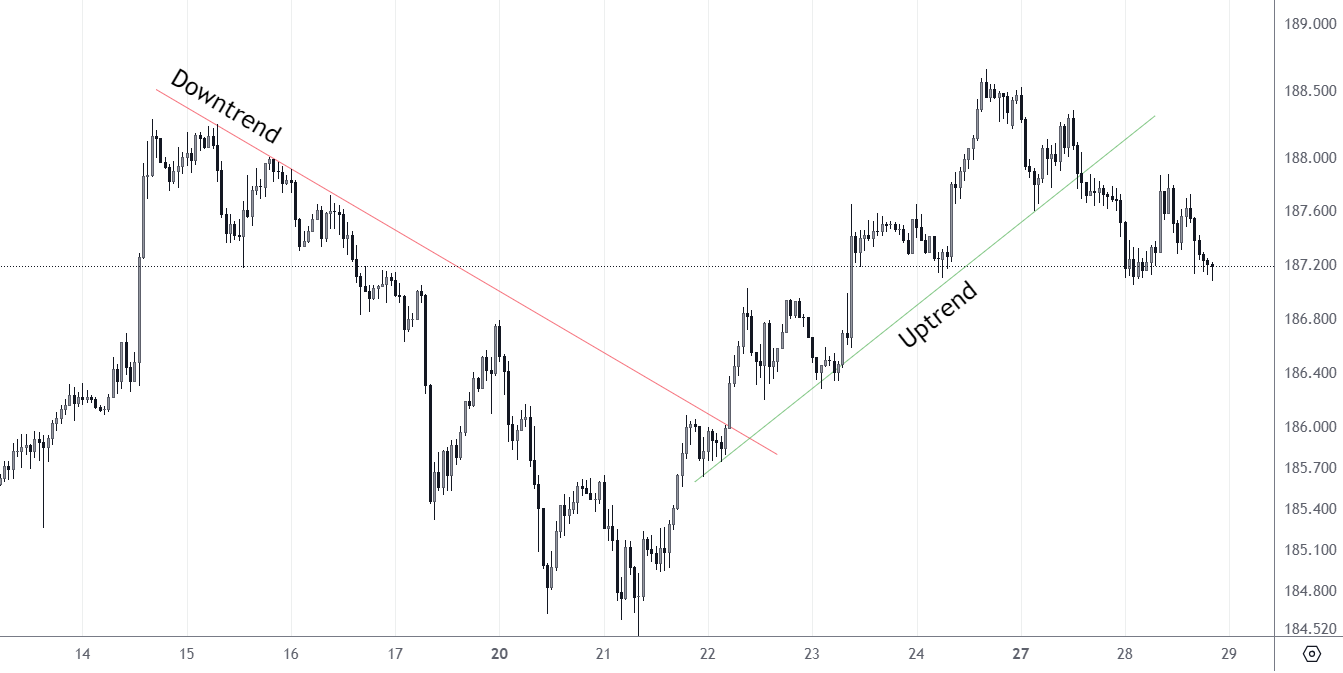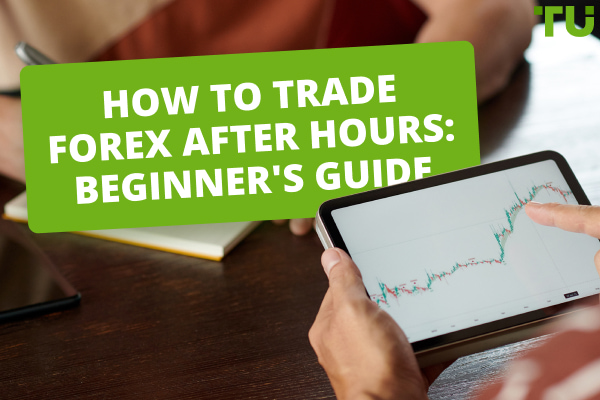How to Identify a Trend in Forex
Since a rising trend is a sequence of higher lows and highs, and a falling trend is a sequence of lower lows and highs, trend lines, channels, and similar graphical patterns can be effectively used to identify the trend. Technical indicators such as ADX or Bollinger Bands can be of additional help.
Forex trading thrives on the keen observation of market patterns. Identifying trends is fundamental to strategizing in the vast and volatile currency markets. In this article, we'll explore the nuances of trend identification, equipping traders with the proficiency to navigate Forex trading waters with confidence.
-
What is the best way to identify trends?
The optimal approach to identifying trends is through technical analysis, employing trend lines and indicators such as moving averages, MACD, and ADX.
-
How do we know that something is a trend?
A consistent pattern of higher highs and higher lows in an uptrend or lower highs and lower lows in a downtrend, sustained over a period, indicates a trend.
-
Which technique can be used to identify a trend?
Trend lines, drawn by connecting significant price highs and lows on a chart, are a primary technique for identifying trends.
-
How do we find trends?
Trends are discerned by analyzing price action on charts and applying technical indicators that reveal persistent directional price movements. Fundamental factors may confirm the strength of the existing trend.
What is a trend?
In the lexicon of Forex trading, a trend signifies a persistent direction in currency price movement. Trends can assume one of three forms:
-
Upward: Often described as bullish, an upward trend is a positive signal, suggesting the strengthening of a currency against its pair.
-
Downward (bearish): Conversely, a bearish trend indicates a currency losing ground, presenting a sequence of depreciations.
-
Sideways (flat, range): A sideways or flat trend denotes a period of equilibrium where the buying and selling pressures are relatively balanced, resulting in a stable price range.
Recognizing these patterns is more than a skill — it's an art that, when mastered, can lead to informed decision-making in Forex trading.
How to identify trends with trend lines
Trend lines are among the most rudimentary tools in a Forex trader's toolkit, yet their simplicity belies their profound utility.

TradingView.com
By connecting a series of highs and lows on a chart, trend lines provide a visual representation of market sentiment and direction.
-
In an uptrend: The classic hallmark of an uptrend is a series of higher highs and higher lows. This pattern illustrates a market in which buyers are in control, consistently pushing prices to new peaks while supporting each dip at a higher level than the previous. To draw a trend line in an uptrend, connect at least two of the lowest points on the chart where price has rebounded. The resulting line should slope upwards, acting as a potential support level from which the price tends to bounce off.
-
In a downtrend Conversely, a downtrend is characterized by a series of lower highs and lower lows, signaling that sellers are dominating the trading landscape. Each peak is lower than its predecessor, and each trough falls below the last, creating a staircase-like descent. A downtrend line is drawn by connecting the lower highs. This line represents resistance, a ceiling that price struggles to breach. When it does, it could be an early indicator of a trend reversal.
-
Reliability of trend lines The reliability of a trend line increases with the number of times the price touches it without breaking through. However, it's crucial to remain vigilant. A break of the trend line can signal a potential reversal or a temporary breach known as a 'fakeout.' Advanced traders often wait for additional confirmation before deciding on their trades.
Best Forex brokers

How to identify trends with indicators
While trend lines offer a hands-on approach to identifying trends, technical indicators serve as the compasses and calculators of the Forex world, quantifying market movements and momentum to signal trends.
Moving averages
Moving averages are pivotal for smoothing out price data to discern a clearer direction. The most common types are the Simple Moving Average (SMA) and the Exponential Moving Average (EMA). A rising moving average indicates an uptrend, while a falling moving average points to a downtrend. Crossovers of different period moving averages can also signal trend changes.
MACD (Moving Average Convergence Divergence)
The MACD is a trend-following momentum indicator that shows the relationship between two moving averages of a currency pair’s price. Traders watch for the MACD line to cross above or below the signal line to identify bullish or bearish momentum.
Bollinger bands
Bollinger Bands measure market volatility and provide insights into overbought or oversold conditions. A tight 'squeeze' of the bands can signal a forthcoming surge in volatility, often leading to a new trend.
ADX (Average Directional Index)
The ADX quantifies trend strength without regard to trend direction. Values above 25 usually indicate a strong trend, while lower values suggest a weaker trend or a range-bound market.
Volume
Volume indicators aren't as commonly used in Forex as in other markets because there's no centralized exchange to measure volume. However, volume can still provide clues about trend strength. For instance, a trend accompanied by high volume is more likely to be sustainable than one with low volume.
To master these indicators, traders must invest time in understanding their unique characteristics and nuances. Combining these tools with a disciplined approach to risk management and an understanding of market fundamentals can enhance a trader's ability to identify and capitalize on Forex trends.
Conclusion
Difficulties in determining trends are due to the fact that:
-
on a lower timeframe it will be, for example, upward, and on a higher timeframe it will be downward;
-
the strength of a trend can be different: from weak (when there seems to be no trend) to extreme;
-
the trend can change at any moment.
Use different techniques to identify trends, and decide which one works best for you before risking real money using trends in forex trading.
Team that worked on the article
Vuk stands at the forefront of financial journalism, blending over six years of crypto investing experience with profound insights gained from navigating two bull/bear cycles. A dedicated content writer, Vuk has contributed to a myriad of publications and projects. His journey from an English language graduate to a sought-after voice in finance reflects his passion for demystifying complex financial concepts, making him a helpful guide for both newcomers and seasoned investors.
Dr. BJ Johnson is a PhD in English Language and an editor with over 15 years of experience. He earned his degree in English Language in the U.S and the UK. In 2020, Dr. Johnson joined the Traders Union team. Since then, he has created over 100 exclusive articles and edited over 300 articles of other authors.
The topics he covers include trading signals, cryptocurrencies, Forex brokers, stock brokers, expert advisors, binary options. He has also worked on the ratings of brokers and many other materials.
Dr. BJ Johnson’s motto: It always seems impossible until it’s done. You can do it.
Mirjan Hipolito is a journalist and news editor at Traders Union. She is an expert crypto writer with five years of experience in the financial markets. Her specialties are daily market news, price predictions, and Initial Coin Offerings (ICO). Mirjan is a cryptocurrency and stock trader. This deep understanding of the finance sector allows her to create informative and engaging content that helps readers easily navigate the complexities of the crypto world.










